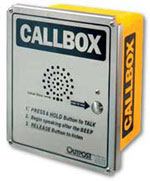When you need a way for clients, students, employees, or anyone else to communicate with you from distant areas of your campus or property, a wireless call box or callbox is one way to do it. A call box is a box made of metal or fiberglass that contains electronic circuitry that enables someone to press a button or pick up a handset and call a central location for assistance. Some callboxes also allow calling a handheld two way radio so that assistance can be mobile.
There are two main types of call box units available, wired and wireless. A wired callbox involves running a cable to it from the central location.This section is about the other kind, the wireless units.
The benefit of a wireless callbox is that you save money by not having to do trenching and running expensive cable to the unit. You also don’t have to pay any air-time or telephone service fees with these wireless systems. As mentioned, another benefit is that since the unit is wireless, people monitoring the units can carry handheld radios that communicate with the call box. That allows your monitoring people to be mobile.
The range of these units is several miles, which can be extended by adding an external antenna. Some units can use radio repeaters to extend this range even more.
If you have existing two-way business radios, you’ll want a system that can integrate with them. Some call boxes can be programmed to be compatible with virtually any brand of VHF or UHF business band radio.
One problem you may have in placing a call box is the lack of available power. You’ll want to choose a system that lets you use battery or AC power. You can also get units that have optional solar power so that they can run for several days on a single day of sunshine.
If you need to remotely control gates, magnetic door locks, or barrier arms from your portable 2-way radio or desktop base station intercom, then select a unit that has this capability. With this ability you can let someone in a gate or door when they call you. There are units that also let you turn on a strobe light at the callbox location to help draw attention to it.
Another useful feature is the ability for call boxes to store a voice message that is played when someone presses its button. This could be a message that gives the caller specific instructions on what to do. These units can also send a second and different voice message alert to the monitoring central location or portable radios. This message could give the call boxes location or it could be an emergency message of some type.
If you have several callboxes in use and you need to know the location of the unit calling in, then you can get a call box that transmits a unique numeric identifier to a radio that has the ability to decode this identifier. This is like having a telephone with Caller ID capability.
By adding a motion detector or some other detection device, you can be alerted when that detection device is activated. Some callboxes will send either a tone alert or a custom voice alert when the detection sensor status changes. If this voice message is not immediately answered, the alert message is resent multiple times.
If you are running your system on battery power, you need a unit that has battery conservation mode. In this mode, only the absolute necessities for operation are powered, and the unit can not accept calls to it; it can only make calls. You can attach an external sensor to automatically put the unit into full power mode when someone is detected near the box. This will allow you to make a call to it.
Other useful features:
- If you want to listen to what’s happening around the call box, then you’ll need a unit that can be paged so you can use the callbox microphone to monitor the sound around it.
- A low battery alert or external power fail tone is sent to the monitoring portable radio or base intercom.
- A paging feature allows selective calling of individual boxes or a group of callboxes simultaneously.
- The busy channel feature prevents someone from transmitting if someone else is using the radio channel.
- Wireless callboxes have fast installation since no wiring is required.
- Entry keypad with built-in relay lets people enter a code at the call box to open a gate or door. Remote opening of the gate by monitoring personnel can still happen also.
These wireless call boxes are being used for applications like parking lots, college campuses, airports, hospitals, construction sites, manufacturing facilities, resorts, hotels, farms, warehouses, delivery docks, campgrounds, gated facilities, or anywhere people may need assistance. So by using call boxes, you can put clear wireless voice communication anywhere you need it, quickly, without expensive trenching and monthly air-time fees.
